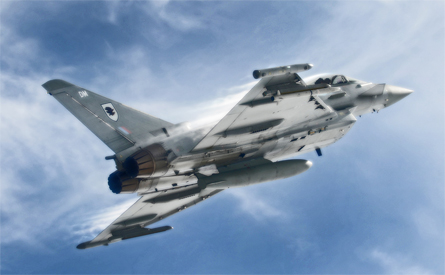The Royal Air Force’s reduced fleet of Eurofighter Typhoons could cost up to £37 billion ($60.2 billion) to acquire and support over the type’s service life, but will not become the UK’s first choice aircraft for ground attack missions until around 2018, according to a new National Audit Office (NAO) report.
Published on 2 March, the government spending watchdog’s ‘Management of the Typhoon project’ overview is highly critical of what it describes as over-optimism, bad decision making and poor cost control on the part of the UK Ministry of Defence.
The RAF has so far taken delivery of 70 Typhoons from the UK’s planned offtake of 160 aircraft. Although it originally committed to buying 232 examples from the four-nation Eurofighter industry consortium, London has already cut 24 from this total by brokering the sale of 72 aircraft to Saudi Arabia, and also stated its intention to renege on a planned Tranche 3B commitment for a final 48.
 |
|---|
© SAC Andrew Seaward/Crown Copyright |
The NAO says the UK's Typhoon project costs have sky-rocketed |
Despite the roughly 30% reduction in aircraft numbers, the NAO says the UK’s total development and production costs are expected to reach £20.2 billion, 20% higher than originally planned. Along with other factors, it calculates that the unit cost of each Typhoon has risen by 75%. Support costs are also one-third higher than originally expected, it says, while elements of the four-nation management structure are “complex and inefficient”.
“Our examination has shown that key investment decisions were taken on an over-optimistic basis; the project suffered from corporate decisions to try to balance the defence budget; and the department did not predict the substantial rate at which costs would rise. None of this suggests good cost control, a key determinant of value for money,” says Amyas Morse, head of the NAO.
However, the watchdog notes that analysis by its consultants “demonstrates that the amount that the department is paying for Typhoon is in line with that expected for similar kinds of aircraft.”
The RAF’s current fleet is now being used to deliver quick reaction alert cover for the UK from Coningsby in Lincolnshire and Leuchars in Scotland, and also for the Falkland Islands.
This emphasis on delivering air defence services from multiple sites has come at the expense of the RAF establishing the Typhoon as a ground-attack asset. The NAO says this will prevent it from becoming the UK’s “aircraft of choice for most ground attack missions for some years”.
“In 2009, the department slowed down the pace with which it planned to introduce new Typhoon squadrons to cut costs. As a result, it reduced the requirement for flying hours by a total of 21,100 hours over the seven years to 2015-16.” Accordingly, the report says it “has prioritised pilot training on air defence roles which is currently its key task”.
Despite the cut in flying hours, the report reveals that the lower than expected availability of spare parts caused a 13% shortfall in planned sorties across the fleet in 2009-10. Some parts had to be sourced from other aircraft to support those fighters deployed in the Falkland Islands, it says.
Meanwhile, the NAO is concerned by plans to reduce the strength of the Typhoon fleet through the retirement of 53 Tranche 1 aircraft by 2019. The retained assets will be used alongside an as-yet undetermined number of Lockheed Martin F-35C Joint Strike Fighters, but it says “the department has acknowledged that there is risk that the eventual fleet size of 107 Typhoons could result in shortfalls against mandated capability levels.”
The Eurofighter programme also involves Germany, Italy and Spain, plus export operators Austria and Saudi Arabia.
Source: FlightGlobal.com
















